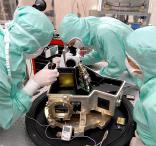The Astrophysics Department of CEA-IRFU, which has scientific and technical responsibility for the MIRIM imager (Mid Infrared Imager) on the MIRI spectro-imager, one of the major instruments of the forthcoming James Webb Space Telescope (JWST), has just delivered the final model of the imager to the Rutherford Appleton Laboratory in England, who will carry out the final test before delivering it for integration into the JWST at the start of 2011. The JWST, a joint mission of the American (NASA), Canadian (CSA) and European (ESA) space agencies, is a satellite weighing more than 6 tonnes and containing a 6.5 m diameter telescope whose launch, on an Ariane 5 rocket, is planned for mid-2014.
The MIRIM camera is a key instrument for achieving the main objective of the JWST, which is to explore the universe as it was 13 billion years ago, when the very first luminous objects were formed. MIRIM should lead to major discoveries in understanding the formation of stars and galaxies, as well as contributing to the search for remote planets thanks to a very innovative device, the phase mask coronagraph, which allows the light from a star to be "extinguished" so that any planet close to the star can be seen more easily.
 View the animation showing the "extinguishing" of a star in the coronagraph
View the animation showing the "extinguishing" of a star in the coronagraph
| Test of the MIRI camera, fitted with a "star mask", a device which allows the light from a star to be "extinguished" to reveal any possible planets. The film shows the movement of the star and its passage in front of the centre of the mask which deletes its light (the sequence is repeated twice). Credit: CEASAp. |
 -Download the animation (ai version, 3.1 MB)
-Download the animation (ai version, 3.1 MB)
[1] Under the overall management of the French space agency, the Centre National d'Etudes Spatiales (CNES), CEA-IRFU managed the work in collaboration with LESIA, the Space Studies and Astrophysics Instrumentation Laboratory (CNRS/ Paris Observatory/University of Paris Diderot/UPMC), the Institute of Spatial Astrophysics at Orsay, IAS (CNRS / University of Paris-Sud 11, OSU-INSU) and the Astrophysics Laboratory of Marseille, LAM (CNRS / University of Provence, OAMP-INSU).
[2] The single crystal of germanium was provided by LESIA and engraved by the CEA Institute of Matter and Radiation (IRAMIS).
Written by: J.M. Bonnet-Bidaud
• Détection des rayonnements Structure et évolution de l'Univers
• Institut de recherche sur les lois fondamentales de l'Univers (Irfu) • Le Département d'Astrophysique (DAp) // UMR AIM
• Laboratoire Anneaux Disques et Planètes • Cosmologie et Evolution des Galaxies • Formation des Etoiles et du Milieu Interstellaire
• JWST


